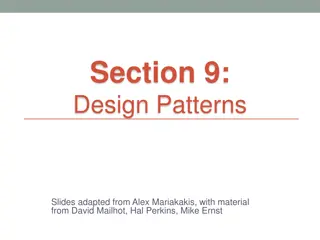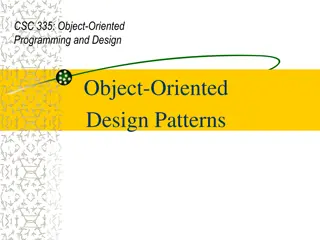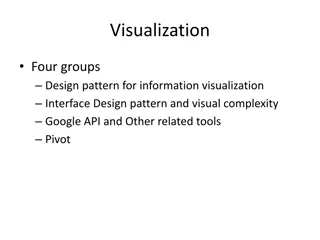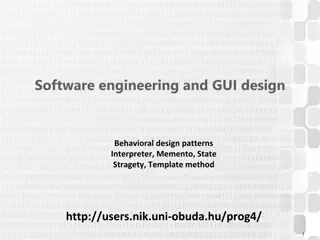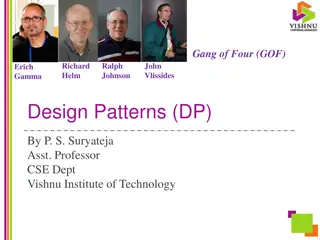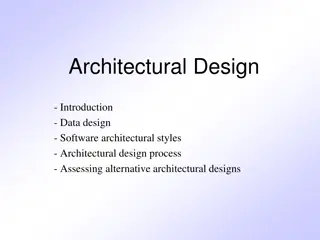
Design Patterns for Software Analysis and Design
Creational design patterns like the Singleton pattern and Factory method pattern, along with examples of each pattern's structure and implementation in the context of software analysis and design.
Download Presentation

Please find below an Image/Link to download the presentation.
The content on the website is provided AS IS for your information and personal use only. It may not be sold, licensed, or shared on other websites without obtaining consent from the author. If you encounter any issues during the download, it is possible that the publisher has removed the file from their server.
You are allowed to download the files provided on this website for personal or commercial use, subject to the condition that they are used lawfully. All files are the property of their respective owners.
The content on the website is provided AS IS for your information and personal use only. It may not be sold, licensed, or shared on other websites without obtaining consent from the author.
E N D
Presentation Transcript
Chapter 7 Design Patterns Software Analysis and Design 0721322 1
Singleton pattern This pattern involves a single class which is responsible of creating an object while making sure that only single object gets created. This pattern provides a way to access its only object which can be accessed directly without need to instantiate the object of the class. 3
Singleton pattern What is required? oWe want to ensure that there is exactly one instance of a class X, and to able to obtain the instance from anywhere in the application. How to achieve that? o make the constructor of X private o define a private static attribute for X of type X o define a public accessor for it. 4
Singleton pattern Structure 5
Example public class Company { private string name; private static Company myComp = new Company("Agate"); private Company(string a) { this.name = a; Console.WriteLine(name); } public static Company getCompany() { return myComp; } } public class Test { static void Main() { Company c = Company.getCompany(); } } 6
Factory method pattern Create individual objects in situations where the constructor alone is inadequate. Use methods to return required objects. 7
Factory method pattern Structure 8
Example 9
public interface Shape { void draw(); } public class Square : Shape { public { Console.WriteLine("drawing a square"); } } public class Rectangle : Shape { public void draw() //override { Console.WriteLine("drawing a rectangle"); } void draw() //override } public class ShapeFactory { public Shape getShape(string type) { if(type.ToLower().Equals("square")) return new Square(); else if (type.ToLower().Equals("rectangle")) return new Rectangle(); else return null; } } 10
public class UseFactory { public static void Main() { ShapeFactory myFactory= new ShapeFactory(); Shape myShape = myFactory.getShape("sQuare"); //get an object of Square class myShape.draw(); //call draw method of Sqaure Shape shape2 = myFactory.getShape("RECTANGLE"); //get an object of Rectangle class shape2.draw(); //call draw method of Rectangle } } 11
Adapter pattern Adapter pattern works as a bridge between two incompatible interfaces. This type of design pattern comes under structural pattern as this pattern combines the capability of two independent interfaces. This pattern involves a single class which is responsible to join functionalities of independent or incompatible interfaces. 13
Adapter pattern A real life example could be a case of card reader which acts as an adapter between memory card and a laptop. You plugin the memory card into card reader and card reader into the laptop so that memory card can be read via laptop. 14
Adapter pattern Structure 15
Example 16
Example 17
Example 18
Facade pattern Facade pattern is a structural design pattern that provides a simplified interface to a library, a framework, or any other complex set of classes. It comes from the term fa ade in architecture. In software terms, Facade pattern hides the complexities of the systems and provides a simple interface to the clients. 19
Facade pattern Structure 20
Example 21
Example 22
Example 23
Example 24
State pattern An object may have a complex behavior that is dependent upon its state. State Design Pattern is used to alter the behavior of an object when it s internal state changes. In this pattern, an object is created which represent various states and a context object whose behavior varies as it's state object changes. 26
State pattern Structure 27
Example 28
Design verification Design Verification is a method to confirm if the output of a designed software product meets the input specifications by examining and providing evidence. The goal of the design verification process during software development is ensuring that the designed software product is the same as specified. Design input is any requirement that is used as the basis for designing purpose. Design output is the result of each design phase and at the end of total design effort. 30








